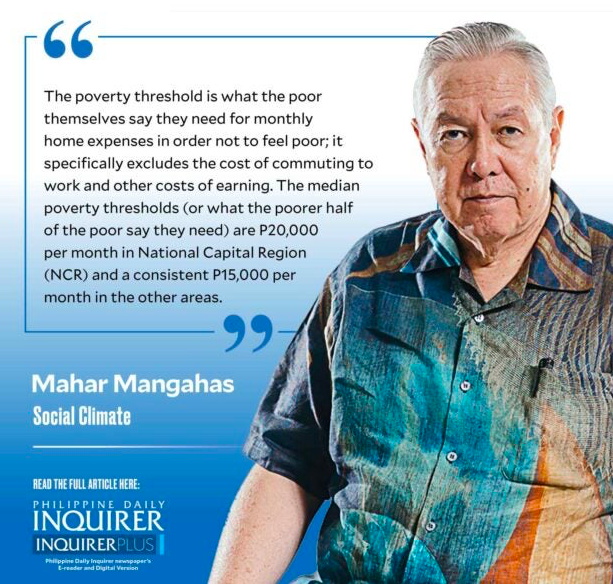Not for the Sona
The recent Social Weather Stations (SWS) report on Self-Rated Poverty in June 2023—“Social Weather Report: 45% of Filipino families feel Poor, down from 51% in March; 33% feel Borderline, and 22% feel Not Poor,” www.sws.org.ph, 7/23/23—was coincidentally released just before the annual State of the Nation Address (Sona).
Self-Rated Poverty (SRP) is one of the core indicators of human well-being that SWS includes in its own-account national surveys on a quarterly basis. These indicators are for everyone in general, not for the government in particular. They are issued not only at Sona-time but year-round.
Other quarterly indicators have to do with hunger, trends, and expectations in the quality of life and the economy, crime victimization and the sense of public safety, and public satisfaction with governance. SWS also surveys the subjects of happiness and satisfaction with life, but only annually.
The poverty rate fell significantly in the past quarter. The new finding that the SRP percentage dropped by 6 points from March to June this year is significant since the national error margin is plus/minus 3 points. It ends the steady climb from 43 in April 2022 to 51 in March 2023. (Bear in mind that the population base constantly grows; SWS applies its current survey percentages to a base of 27.44 million families, drawn from official sources.)
But to connect the last two points and then extrapolate into the future would be foolish, given the volatility in 140 surveys of SRP since 1983 (“40 years of poverty surveying,” 1/7/2023). The current 45 and the previous 51 together put the running-average SRP for 2023 at 48 percent. So far, it is a recovery from the 2022 average. It is still above the 2021 average of 46 percent.
To safely say that the pandemic-time crisis is completely over, I would look for a four-quarter average of 45 percent, to match pre-pandemic 2019, which included the all-time record low 38 percent in 2019Q1 (“Complete the recovery first,” 6/17/23).
The people’s poverty thresholds are reasonable, and their poverty gaps are substantial. The poverty threshold is what the poor themselves say they need for monthly home expenses in order not to feel poor; it specifically excludes the cost of commuting to work and other costs of earning.
The median poverty thresholds (or what the poorer half of the poor say they need) are P20,000 per month in National Capital Region (NCR) and a consistent P15,000 per month in the other areas. The median monthly poverty gaps (or what the poorer half of the poor say they lack, compared to their thresholds) are P9,000 in NCR, P7,000 in Balance Luzon, P6,000 in Visayas, and P7,000 in Mindanao.
The recent improvement was mainly in Southern Philippines. The SWS surveys are designed for analysis up to the area level: NCR, Balance Luzon, Visayas, and Mindanao.
The 6-point fall in SRP at the national level was due to changes of -5 in NCR, -4 in Balance Luzon, -8 in Visayas, and -8 in Mindanao. The changes in the latter two areas are significant since the error margin at the area level is plus/minus 6 points.
Self-Rated Food Poverty (SRFP) also fell significantly. The food-poor are the families that regard the quality—as distinguished from the quantity, which is handled by the indicator of hunger (a forthcoming release)—of their food as Mahirap.
By area, the latest SRFP percentages are 52 in Mindanao, 45 in Visayas, 33 in NCR, and 31 in Balance Luzon. It is the sixth consecutive quarter that Metro Manilans are relatively more food-poor than others in Luzon.The national SRFP percentage fell from 39 in March to 34 in June; that 5-point drop is significant. Area-wise, the drops were by 1 point in NCR, 3 points in Balance Luzon, 3 points in Visayas, and 12 points in Mindanao. The Mindanao drop was highly significant.
The new national food poverty rate lowers the 2023 running average rate to 36.5, but that is still above the averages of 33 in 2022, 31 in 2021, 31 in 2020 (from only one survey), and 31 in 2019.
The people’s food-poverty thresholds and food-poverty gaps are reasonable. The latest median monthly food-poverty thresholds (or what the poorer half of the food-poor say they need in order not to be food-poor) are P8,500 in NCR, P7,000 in Balance Luzon, P8,000 in Visayas, and P7,000 in Mindanao.
Compared to 2023Q1, the median food-poverty threshold fell in NCR (by P1,500), fell in Balance Luzon (by P2,000), stayed the same in Visayas, but rose in Mindanao (by P1,000).
The latest median monthly food-poverty gap (or what the poorer half of the food-poor say they lack, compared to their food thresholds) is P3,000 in all four survey areas—it’s easy to remember: P100 per day. The median food-poverty gap fell by P2,000 in NCR and fell by P1,000 in Balance Luzon, but was steady in Visayas and Mindanao, compared to 2023Q1.
SWS offers its survey trends for analysis by regional development experts of all sectors. They are not intended merely for the annual Sona.
Contact: [email protected].
Disclaimer: The comments uploaded on this site do not necessarily represent or reflect the views of management and owner of Cebudailynews. We reserve the right to exclude comments that we deem to be inconsistent with our editorial standards.

